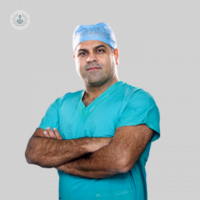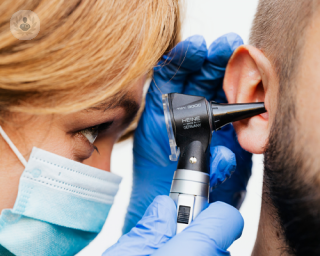Eustachian tube dysfunction
Mr Karan Kapoor - Otolaryngology / ENT
Created on: 09-02-2020
Updated on: 04-25-2023
Edited by: Conor Lynch
What is eustachian tube dysfunction?
The small tubes which equalise ear pressure and drain fluid from the middle ear, located between your middle ears (behind your ear drum) and upper throat, can become blocked. When this happens, pain, hearing difficulties, and a feeling of fullness in the ears can occur. This is known as eustachian tube dysfunction (ETD).

What causes eustachian tube dysfunction?
There are various causes of ETD. Allergies and respiratory conditions like colds are the most common cause. This is because they can inflame or clog your eustachian tubes with mucus. Furthermore, sinus infections raise the chances of developing ETD.
Altitude changes can also cause problems with your ears. Moreover, the eustachian tubes may experience problems due to effects of doing various activities including:
- hiking
- travelling through mountains
- flying on a plane
- taking the elevator
Other conditions that can lead to a higher likelihood of being prone to ETD include obesity and smoking. Eustachian tubes are smaller in children so mucus and germs are more likely to get trapped. Furthermore, their immune systems are still developing so they are more likely to get colds or respiratory infections.
What are the symptoms of eustachian tube dysfunction?
The symptoms of ETD can include:
- Fullness in the ears
- The sensation of your ears being blocked
- Hearing changes
- Tinnitus
- Ear keeps popping
- Clicking or crackling in ear when swallowing
- Ear tickling
- Pain
ETD can resolve depending on the initial cause. If symptoms are caused from altitude changes, they may get better once you return to the altitude you're used to. Longer-lasting symptoms may occur if ETD results from other causes or illnesses.
How is eustachian tube dysfunction treated?
ETD treatment is dependent on its severity and cause. Treatment can include:
- Home remedies
- Over-the-counter medication
- Prescribed medication
Usually, ETD resolves without treatment. However, speak to your doctor if two weeks pass and your symptoms are severe and have persisted. Home remedies for ETD include the following:
- Chewing gum
- Swallowing
- Yawning
- Breathing out using your nostrils while your mouth is closed.
- A saline nasal spray to assist in cleaning out passageways.
If your baby has ETC symptoms, give them a bottle or dummy to suck. Pain relievers such as ibuprofen can relieve ear pain. Antihistamines can reduce allergy-related ETC symptoms.
It may be necessary to have more invasive treatments in severe ETD cases. In some cases, pressure equalisation tubes (PETs) can be implanted to equalise ear pressure and to help with frequent or chronic middle ear infections.
Also, if the eustachian tube isn't functioning correctly, built-up fluids may also need to be drained. The procedures to do this involves making a small cut in the eardrum. In severe cases, ETD may also cause middle ear infection, glue ear (fluid build up in the middle ear) and eardrum retraction.
What specialist treats eustachian tube dysfunction?
Both otologists, who specifically treat the ear, and ENT doctors, who specialise in ear, nose and throat conditions, treat ETD.






